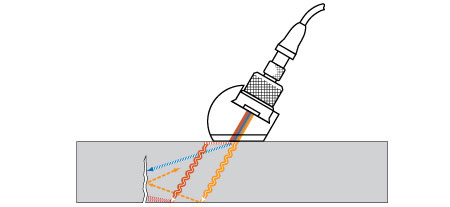Ultrasonic Flaw Detection Tutorial
9.2 CDS/Creeping Waves
CDS wedges are specialized plastic wedges used for crack detection and quick determination of whether a crack is ID connected. This technique can further indicate if the crack is located in the inner, middle or outer third of the part thickness. CDS stands for Creeping-Direct-Shear, also known as the 30-30-70 technique. CDS wedges use single element transducers to simultaneously generate three waves in the test piece.

- An OD creeping wave creates a 31.5 degree indirect shear wave (red path in drawing above), which mode converts to an ID creeping wave. This will produce a reflected signal from all ID connected cracks.
- A 30 degree shear wave (orange path) will reflect off the material ID at the critical angle to create a 70 degree longitudinal wave. A signal will be received by the transducer from cracks that extend into the midwall region or deeper.
- A 70 degree direct longitudinal wave (blue path) that will create a tip diffraction signal from very deep cracks.
The presence or absence of these signals are the key to interpreting test results. For a detailed discussion of typical test setup and interpretation, see Detection and Sizing Techniques of ID Connected Cracking.
Sorry, this page is not available in your country
Let us know what you're looking for by filling out the form below.